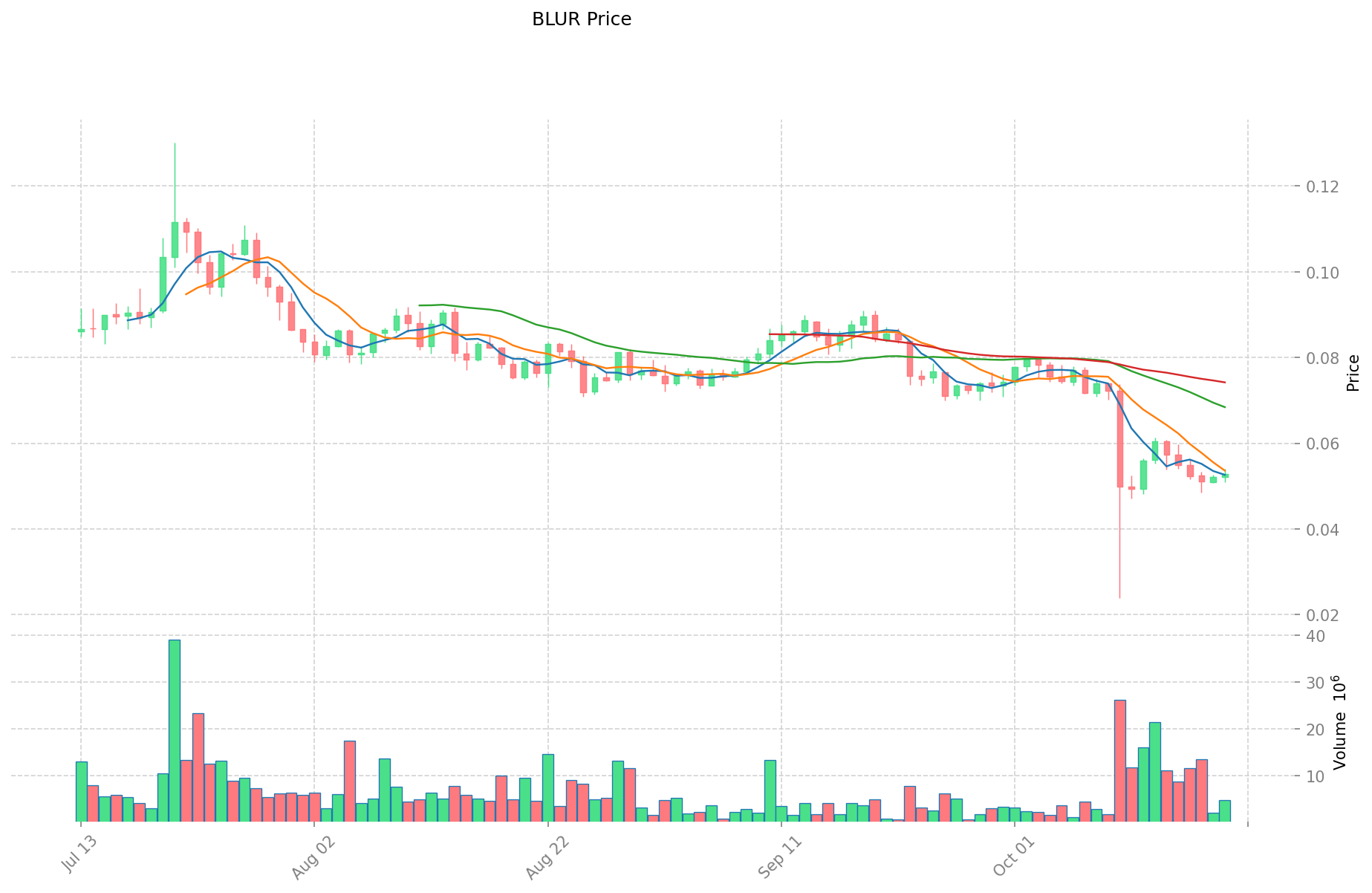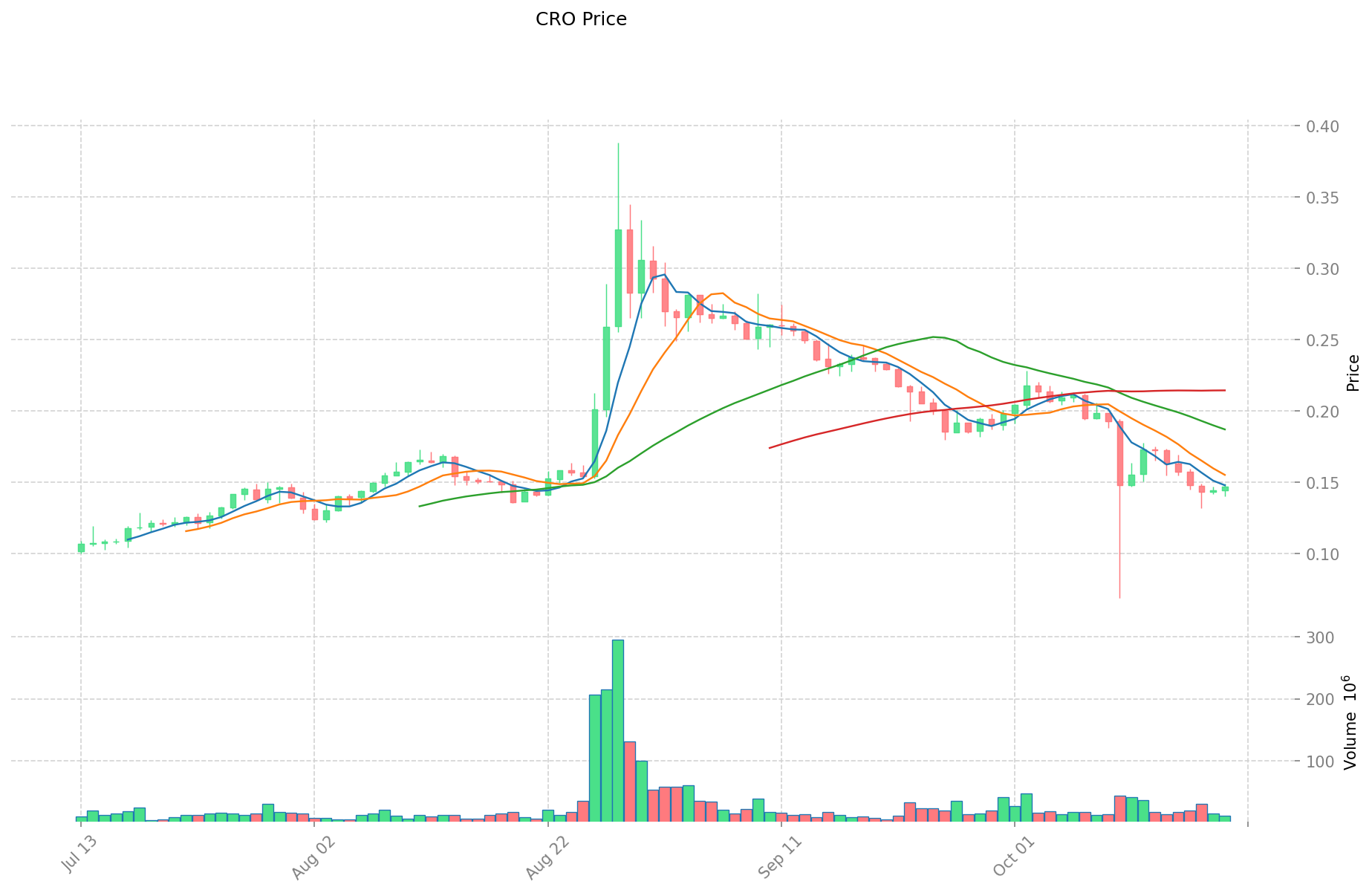BLUR vs CRO: The Battle for NFT Marketplace Dominance
Introduction: BLUR vs CRO Investment Comparison
In the cryptocurrency market, the comparison between BLUR and CRO has always been an unavoidable topic for investors. The two not only have significant differences in market cap ranking, application scenarios, and price performance, but also represent different positions in the crypto asset space.
BLUR (BLUR): Since its launch in 2023, it has gained market recognition for its decentralized NFT marketplace and aggregator.
Cronos (CRO): Launched in 2018, it has been hailed as a leading blockchain ecosystem, representing one of the largest addressable user bases in the crypto world.
This article will provide a comprehensive analysis of the investment value comparison between BLUR and CRO, focusing on historical price trends, supply mechanisms, institutional adoption, technological ecosystems, and future predictions, attempting to answer the question investors are most concerned about:
"Which is the better buy right now?"
I. Price History Comparison and Current Market Status
BLUR (Coin A) and CRO (Coin B) Historical Price Trends
- 2023: BLUR launched and reached its all-time high of $5.4146 on February 14, 2023.
- 2021: CRO hit its all-time high of $0.965407 on November 24, 2021, likely influenced by the overall crypto bull market.
- Comparative analysis: BLUR has experienced a significant decline from its all-time high, currently trading at $0.05276. CRO has also seen a substantial drop from its peak but has maintained a higher price at $0.14675.
Current Market Situation (2025-10-20)
- BLUR current price: $0.05276
- CRO current price: $0.14675
- 24-hour trading volume: BLUR $252,877.68 vs CRO $1,566,315.09
- Market Sentiment Index (Fear & Greed Index): 29 (Fear)
Click to view real-time prices:
- View BLUR current price Market Price
- View CRO current price Market Price


II. Core Factors Affecting the Investment Value of BLUR vs CRO
Supply Mechanisms Comparison (Tokenomics)
- BLUR: Total supply of 3 billion BLUR tokens with gradual distribution through airdrops to the community, with a significant portion allocated to traders, creators, and bidders in the NFT marketplace ecosystem
- CRO: Fixed maximum supply of 30 billion tokens with regular token burns to reduce circulating supply, including a notable burn of 70 billion CRO in February 2021 reducing total supply from 100 billion to 30 billion
- 📌 Historical pattern: Deflationary mechanisms like CRO's burns have historically created upward price pressure during market expansion phases, while BLUR's distribution model drives engagement but may create selling pressure during token unlocks.
Institutional Adoption and Market Applications
- Institutional holdings: CRO has greater institutional integration through Crypto.com's partnerships with major brands like UFC, Formula 1, and PSG, while BLUR has gained traction among NFT-focused funds
- Enterprise adoption: CRO has broader payment applications through the Crypto.com ecosystem including Visa cards and merchant services, while BLUR remains focused specifically on NFT marketplace transactions
- Regulatory attitudes: Both tokens face regulatory scrutiny, but CRO's longer operating history and compliance focus may provide relative stability in uncertain regulatory environments
Technical Development and Ecosystem Building
- BLUR technical upgrades: Advanced NFT marketplace features including aggregation, zero-fee trading, and royalty enforcement mechanisms positioning it as a competitor to OpenSea
- CRO technical development: Evolution from Crypto.com Chain to Cronos, an EVM-compatible chain supporting DeFi and NFT applications, with cross-chain functionality
- Ecosystem comparison: CRO offers a more diverse ecosystem spanning DeFi, payments, NFTs and exchange services, while BLUR has deeper specialization specifically in NFT trading with advanced tools for professional traders
Macroeconomic Factors and Market Cycles
- Performance in inflationary environments: CRO's diverse utility across payment systems provides some inflation hedge characteristics, while BLUR's correlation to NFT market cycles makes it more speculative
- Macroeconomic monetary policy: Both tokens show sensitivity to broader crypto market conditions, which are increasingly correlated with traditional risk assets in response to interest rate changes
- Geopolitical factors: CRO's global payment infrastructure positions it better for cross-border transactions, while BLUR remains primarily focused on the digital art economy
III. 2025-2030 Price Prediction: BLUR vs CRO
Short-term Prediction (2025)
- BLUR: Conservative $0.0400672 - $0.05272 | Optimistic $0.05272 - $0.0774984
- CRO: Conservative $0.1349272 - $0.14666 | Optimistic $0.14666 - $0.1554596
Mid-term Prediction (2027)
- BLUR may enter a growth phase, with an estimated price range of $0.0363472109 - $0.08855502292
- CRO may enter a steady growth phase, with an estimated price range of $0.11519820348 - $0.2229642648
- Key drivers: Institutional capital inflow, ETF developments, ecosystem growth
Long-term Prediction (2030)
- BLUR: Base scenario $0.072144291563285 - $0.112725455567634 | Optimistic scenario $0.112725455567634 - $0.12625251023575
- CRO: Base scenario $0.176485096999081 - $0.25953690735159 | Optimistic scenario $0.25953690735159 - $0.288085967160264
Disclaimer: The above predictions are based on historical data and current market trends. Cryptocurrency markets are highly volatile and subject to rapid changes. These projections should not be considered as financial advice. Always conduct your own research before making investment decisions.
BLUR:
| 年份 | 预测最高价 | 预测平均价格 | 预测最低价 | 涨跌幅 |
|---|---|---|---|---|
| 2025 | 0.0774984 | 0.05272 | 0.0400672 | 0 |
| 2026 | 0.067062476 | 0.0651092 | 0.057947188 | 23 |
| 2027 | 0.08855502292 | 0.066085838 | 0.0363472109 | 25 |
| 2028 | 0.1074753983394 | 0.07732043046 | 0.0417530324484 | 46 |
| 2029 | 0.133052996735568 | 0.0923979143997 | 0.072994352375763 | 75 |
| 2030 | 0.12625251023575 | 0.112725455567634 | 0.072144291563285 | 113 |
CRO:
| 年份 | 预测最高价 | 预测平均价格 | 预测最低价 | 涨跌幅 |
|---|---|---|---|---|
| 2025 | 0.1554596 | 0.14666 | 0.1349272 | 0 |
| 2026 | 0.220547308 | 0.1510598 | 0.096678272 | 2 |
| 2027 | 0.2229642648 | 0.185803554 | 0.11519820348 | 26 |
| 2028 | 0.241173013092 | 0.2043839094 | 0.155331771144 | 39 |
| 2029 | 0.29629535345718 | 0.222778461246 | 0.16040049209712 | 51 |
| 2030 | 0.288085967160264 | 0.25953690735159 | 0.176485096999081 | 76 |
IV. Investment Strategy Comparison: BLUR vs CRO
Long-term vs Short-term Investment Strategies
- BLUR: Suitable for investors focused on NFT market growth and ecosystem potential
- CRO: Suitable for investors seeking broader crypto ecosystem exposure and payment infrastructure development
Risk Management and Asset Allocation
- Conservative investors: BLUR: 20% vs CRO: 80%
- Aggressive investors: BLUR: 40% vs CRO: 60%
- Hedging tools: Stablecoin allocation, options, cross-token portfolios
V. Potential Risk Comparison
Market Risk
- BLUR: High volatility due to NFT market cycles and token distribution events
- CRO: Exposure to overall crypto market trends and competition in the payment sector
Technical Risk
- BLUR: Scalability challenges, network stability during high-volume NFT drops
- CRO: Network congestion, potential security vulnerabilities in DeFi protocols
Regulatory Risk
- Global regulatory policies may impact both tokens differently, with CRO potentially facing more scrutiny due to its payment services
VI. Conclusion: Which Is the Better Buy?
📌 Investment Value Summary:
- BLUR advantages: Specialized NFT marketplace features, potential for rapid growth in the digital art economy
- CRO advantages: Diverse ecosystem, established partnerships, broader utility in payments and DeFi
✅ Investment Advice:
- New investors: Consider a balanced approach, leaning towards CRO for its established ecosystem
- Experienced investors: Explore a mixed portfolio, potentially overweighting BLUR for higher risk-reward
- Institutional investors: Evaluate CRO for its payment infrastructure potential, while considering BLUR for NFT market exposure
⚠️ Risk Warning: The cryptocurrency market is highly volatile. This article does not constitute investment advice. None
VII. FAQ
Q1: What are the main differences between BLUR and CRO? A: BLUR is focused on the NFT marketplace ecosystem, while CRO is part of a broader crypto ecosystem including payments, DeFi, and exchange services. BLUR has a total supply of 3 billion tokens distributed through airdrops, while CRO has a fixed maximum supply of 30 billion tokens with regular burns.
Q2: Which token has performed better historically? A: CRO reached its all-time high of $0.965407 in November 2021, while BLUR hit its all-time high of $5.4146 in February 2023. However, both have seen significant declines since their peaks, with CRO currently maintaining a higher price at $0.14675 compared to BLUR's $0.05276 as of October 20, 2025.
Q3: How do the future price predictions for BLUR and CRO compare? A: By 2030, BLUR is predicted to reach a base scenario of $0.072144291563285 - $0.112725455567634, while CRO is expected to reach $0.176485096999081 - $0.25953690735159. CRO generally shows higher predicted values in the long term.
Q4: What are the main factors affecting the investment value of BLUR and CRO? A: Key factors include supply mechanisms, institutional adoption, market applications, technical development, ecosystem building, and macroeconomic factors. CRO benefits from broader institutional partnerships and diverse applications, while BLUR specializes in the NFT marketplace.
Q5: How should investors allocate their portfolio between BLUR and CRO? A: Conservative investors might consider allocating 20% to BLUR and 80% to CRO, while aggressive investors could opt for 40% BLUR and 60% CRO. The exact allocation depends on individual risk tolerance and investment goals.
Q6: What are the main risks associated with investing in BLUR and CRO? A: Both tokens face market risks related to crypto volatility. BLUR is particularly sensitive to NFT market cycles, while CRO is exposed to competition in the payment sector. Technical risks include scalability challenges for BLUR and potential security vulnerabilities in DeFi protocols for CRO. Both face regulatory risks, with CRO potentially facing more scrutiny due to its payment services.
Q7: Which token is considered a better buy for different types of investors? A: New investors might lean towards CRO for its established ecosystem. Experienced investors could explore a mixed portfolio, potentially overweighting BLUR for higher risk-reward. Institutional investors may evaluate CRO for its payment infrastructure potential while considering BLUR for NFT market exposure.
Share
Content